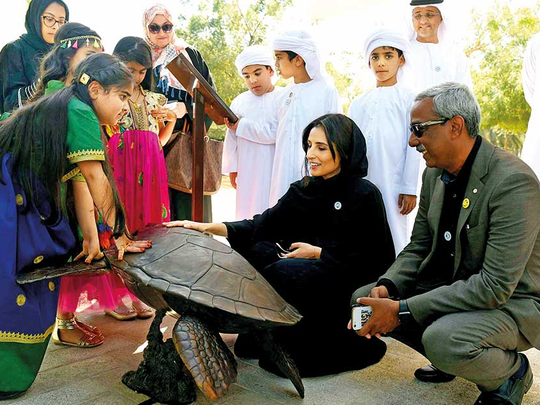
Abu Dhabi: Five beautiful sculptures of wildlife species unveiled at an Abu Dhabi park on Tuesday symbolise not only the UAE’s achievements in species conservation but women’s empowerment and environmental education also, according to a senior official.
The five life-size bronze sculptures of the UAE’s iconic wildlife species installed at Umm Al Emarat Park tell the success story of the UAE’s decades-long conservation programmes that have helped increase the population of those threatened species, said Razan Khalifa Al Mubarak, secretary-general of the Environment Agency — Abu Dhabi (EAD) after unveiling the sculptures on Tuesday.
In celebration of Mother’s Day, Shaikh Hamdan Bin Zayed Al Nahyan, the Ruler’s Representative in Al Dhafra Region and chairman of the EAD, gifted the sculptures to Her Highness Shaikha Fatima Bint Mubarak, Chairwoman of the General Women’s Union, Supreme Chairwoman of the Family Development Foundation, and Chairperson of the Supreme Council for Motherhood and Childhood, and the Mother of the Nation.
The sculptures, representing some of the UAE’s key threatened and endangered species, collectively known as “Jewels of Abu Dhabi” including the dugong, Arabian oryx, greater flamingo, Hawksbill turtle and Saker falcon, will be permanently hosted at the park for raising public environmental awareness.
Shaikh Hamdan said: “Mother’s Day is a fitting day to express our appreciation towards the Mother of the Nation for her exceptional efforts in supporting Emirati women and providing them with equal opportunities to contribute to the building of our great nation. Emirati women have achieved outstanding progress over the past decades. This is a source of pride not only for our society but for the entire world,” he said.
Expressing her happiness upon receiving the gift, Shaikha Fatima said: “Shaikh Zayed cherished our environment because it is an integral part of our country, our history, our religion and our heritage. His foresight and vision long preceded the present-day global conservationists’ movement.”
Al Mubarak said the achievements of Emirati women were inspired by Shaikha Fatima. “Emirati women hold 46 per cent of the leadership positions in the EAD. All those women leaders were inspired by Shaikha Fatima.”
She said 1.8 million children have participated in the EAD’s educational programmes in the past 20 years and sculptures represented that achievement as well. The children visiting the park will ask about these species and continue to get education about their conservation, she said.
The sculptures, commissioned by the EAD and created by world-renowned British artist Gill Parker, are accompanied by interesting information about the species and a description about how Shaikh Zayed Bin Sultan Al Nahyan inspired governmental efforts to protect them.
The Jewels of Abu Dhabi
Dugong
Abu Dhabi is home to the world’s second largest population of dugongs, which are found mostly around Bu Tinah Island. They have been studied and monitored by the Environment Agency – Abu Dhabi since 1999.
Greater flamingos
Al Wathba Wetland Reserve is considered Falmingos’ favourite site for nesting and breeding. The first successful breeding witnessed in Al Wathba was in 1998. Following this, Shaikh Zayed Bin Sultan Al Nahyan issued directives to announce this location as a protected area.
Saker falcon
Like most Arab falconers, the late Shaikh Zayed traditionally released his falcons back into the wild at the end of the hunting season. This practice inspired the Shaikh Zayed Falcon Release Programme, which began in 1995, and is now overseen by the Abu Dhabi Falcon Hospital, with support from the Environment Agency – Abu Dhabi. It is considered one of the most impactful release programmes in the world and, since it began, more than 1,800 falcons have been released back into their natural habitat, in countries such as Pakistan, Iran, Kyrgyzstan and Kazakhstan. A great favourite with falconers, the Saker falcon is a large, powerful bird of prey with an exceptionally broad wingspan for its size.
Arabian oryx
As the Arabian oryx neared extinction, Shaikh Zayed arranged for the capture of two breeding pairs. Today, thanks to the Shaikh Mohammad Bin Zayed Arabian Oryx Release Programme, implemented by the EAD, the numbers of Arabian oryx in the UAE have increased to over 10,000, of which 5,000 are in Abu Dhabi emirate. Moreover, efforts have led to the International Union for the Conservation of Nature (IUCN) downlisting the status of the Arabian oryx from “Endangered” to “Vulnerable” in 2011. The Arabian oryx, as part of the programme, is also gradually being reintroduced into protected areas, across the UAE, Oman and Jordan.
Hawksbill turtle
Of the seven species of marine turtles in the world, two are found in Abu Dhabi’s waters: the critically endangered Hawksbill turtle and the endangered Green turtle. The Hawksbill nests on the sandy beaches of several offshore islands and can be found in the waters around Bu Tinah Island, which has been recognised by the United Nations as one of the most important sanctuaries for turtles in the Indian Ocean. The marine environment, in particular, held an emotional value to Shaikh Zayed. He considered it a treasured part of our heritage, our present and our future.












